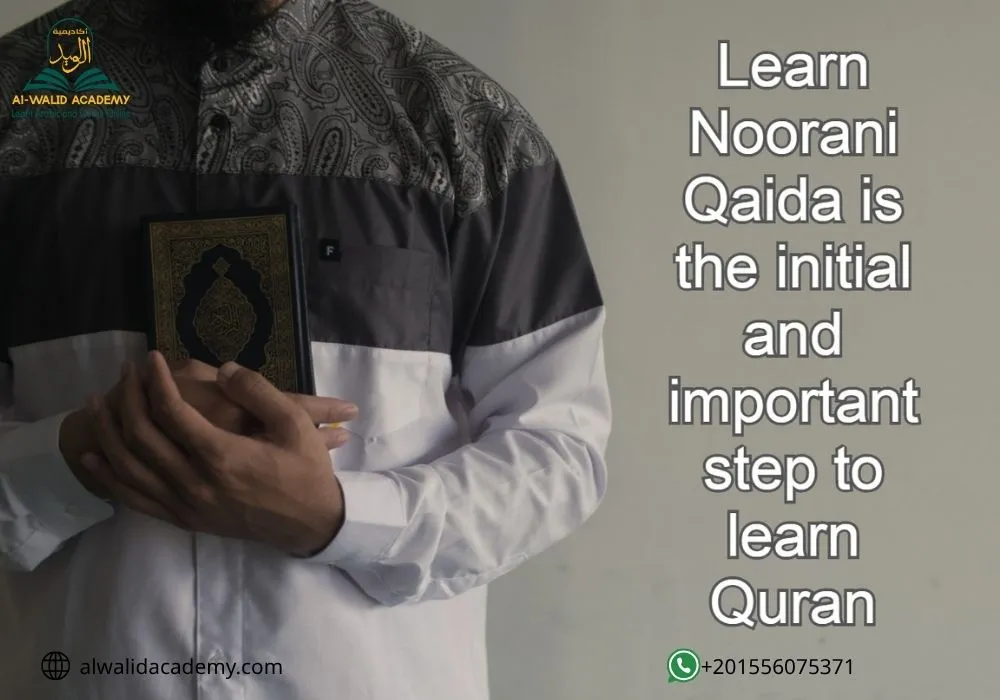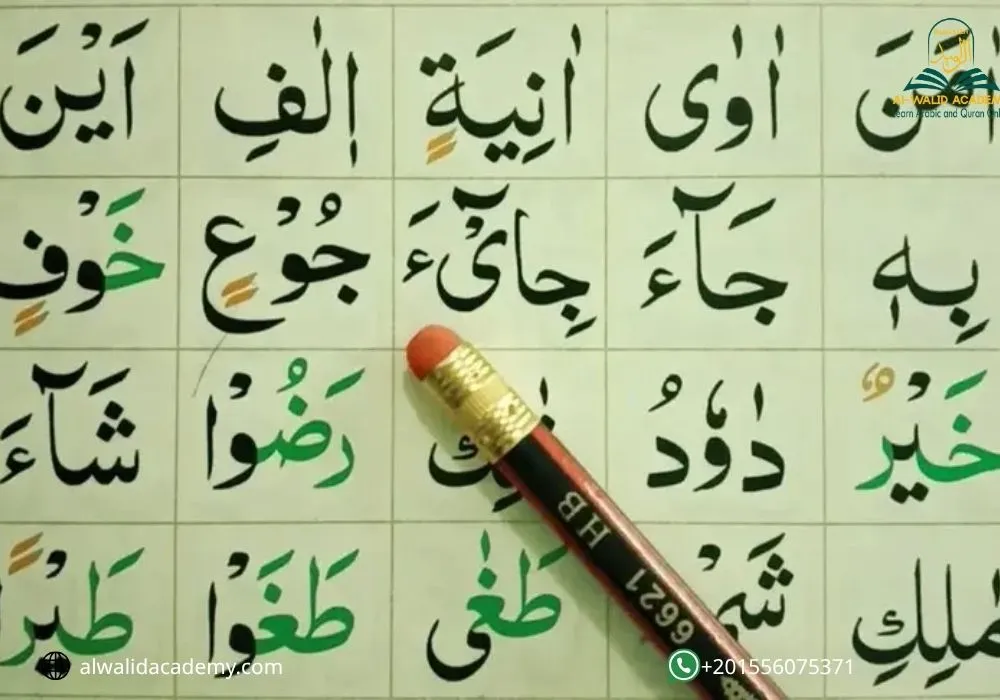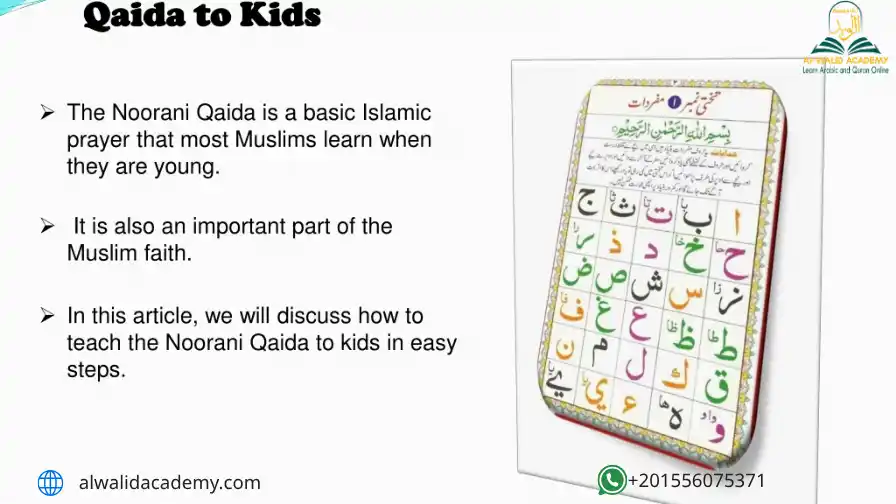Are you wondering how to start the first step of Quran memorization with your child? Let’s explore how to teach Noorani Qaida to kids in a way that keeps it simple and turns learning into something fun they actually enjoy.
We’ll share ideas, games, and exercises that will make them love learning without feeling like it’s a heavy duty.
What does Noorani Qaida mean and why was it created?
Noorani Qaida is simply a small book divided in a smart way that teaches kids Arabic letters and their sounds step by step, and introduces them to Tajweed early in a light and easy way.
The idea of this book is to be the foundation that the child stands on before holding a full Mushaf, like drawing them a roadmap so they can start reading correctly without confusion or feeling that it’s heavy.
While your child begins their journey with our Online Noorani Qaida Course, you can also explore our Quran Memorization Course to help them continue beyond letter recognition into full recitation and memorization.
Why is it important to start early between the ages of 3 to 6?
This exact age is the golden chance to start introducing the child to Noorani Qaida and make them love the Quran early.
-
At this age, kids’ minds are like sponges… anything that enters stays quickly, and their ears also catch the correct pronunciation from the first time.
-
If we start with them early, they are more ready to love memorization and reading, and this plants in them a good habit they will continue with for life.
-
Also, an early start makes their letter pronunciation accurate and improves their memory while they’re still young.
Read about: Best Age for Learning Quran Online
Educational benefits proven by studies
Let’s find out together the benefits that make Noorani Qaida the most important start for any child beginning Quran memorization and reading:
-
Noorani Qaida doesn’t just teach the child to read the Quran; it also develops listening, speaking, and even regular reading and writing skills.
-
American studies (like the National Reading Panel) showed that teaching letters with their sounds – known as phonics – helps kids understand and read faster with more confidence.
-
There’s also something called phonemic awareness, which basically means that the child can distinguish between letter sounds, making it easier to form and understand words.
Read about: Summer Quran Classes for Kids
How is the method applied with kids?
Noorani Qaida is divided into levels:
-
starting with letters and their shapes, then vowel marks.
-
Light Tajweed like Madd and Idghaam.
Each level includes simple exercises that help parents or teachers know if the child understood or needs a re‑explanation.
The advantage is that it goes step by step, so the child doesn’t feel pressured or like they are suddenly facing something hard.
How to teach Noorani Qaida to kids step by step?
The Qaida is designed like a ladder for the child to climb step by step, so they can absorb everything calmly:
-
First level (Beginner): The child learns the Arabic letters, their shapes, and the sound of each letter individually, focusing on correct pronunciation without vowel marks.
-
Second level (Intermediate): After the child memorizes the letters well, we start adding vowel marks (fatha, kasra, dhamma) and introduce shaddah and sukoon gradually with simple words.
-
Third level (Advanced): Here we start introducing simple Tajweed rules like Madd, Idghaam, and Izhaar, and apply them to short words and verses suitable for their age.
Parents who join our kids’ Qaida classes often ask about next steps — our Tajweed Course and Quran Recitation Course are perfect to build on the solid foundation they gain from Qaida lessons.
Goals and timeline suitable for the child
The ideal duration to finish Noorani Qaida is usually between 6 to 10 months if the child studies consistently without interruption.
The daily lesson should not exceed 20 – 30 minutes so the child stays focused and doesn’t get bored.
Every period – for example, monthly – we review the progress and see where the child has reached, and decide whether to stay on the same level or move to the next step.
Cooperation between parents and teacher
Success in teaching Noorani Qaida is not only the teacher’s responsibility; there must be continuous follow‑up from the parents:
-
They should know what was explained in the lesson so they can review with the child at home.
-
They should listen to the child’s reading even for 5 minutes daily, before sleep or after school.
A good idea is that parents record the child’s recitation every week and compare these recordings with the teacher to notice the progress.
Constant communication between parents and the teacher makes the child take the process more seriously and feel that everyone cares about them and their progress.
Many kids who start with Qaida enjoy moving on to our Quranic Arabic Course, which introduces them to the language of the Qur’an and connects perfectly with the letters they’ve just mastered.

How to teach kids Arabic letters and phonemic awareness?
Let’s learn how to introduce Arabic letters to kids in a way that connects shapes with sounds and makes reading fun and simple.
What does teaching letters with Phonics mean?
Before we start, here’s why the phonics method is different and why it helps kids learn faster.
-
The idea here is that we don’t just make the child memorize the shape of the letter, but also teach them how to pronounce it correctly and where the sound comes from in the mouth or throat.
-
When the child connects the letter’s shape with its proper sound, it becomes easier for them later to form words and read the Quran without confusion.
-
This method starts with listening first so the child’s ear gets used to distinguishing sounds, and then we move step by step to reading and writing.
Ideas and tools to make kids love learning letters
Simple tools and playful ideas can turn learning letters into something exciting for kids.
-
Use letter flashcards: hold up a card with one letter and ask your child to say the sound out loud. We can also add a picture of something familiar that starts with the same letter, like “B – Batta (duck),” to help the information stick in their memory.
-
Playdough or sand play: Let them form letters with clay or draw them in sand. This combines touch and sight, making learning fun and easy to remember.
-
Touch‑and‑sound toys: Toys that produce the sound of the letter when the child presses or touches them help them quickly connect sound with shape and make the learning process more engaging.
Learn more: Learn The Quran With Tajweed For Kids
Why do we focus on listening before reading?
Listening practice comes first because kids need to hear and recognize sounds before they can read them.
-
Before the child starts reading, their ear should first be trained to listen and distinguish between similar letters:
Like the difference between “B” and “T” or “S” and “Ṣ.”
-
After they get used to hearing and recognizing the sound, it becomes easier for them to read the word without mixing or making mistakes.
-
Studies show that kids who train on listening first become faster at reading and make fewer pronunciation mistakes.
Alongside Noorani Qaida, we provide Learning Arabic for Beginners and Modern Standard Arabic classes, so kids can develop speaking and reading skills beyond the Qur’an
Learn Quran, Arabic, and Islamic Studies with certified teachers in fun, interactive, and personalized sessions. Join thousands of students around the world and begin your path today!
How to make teaching Noorani Qaida fun and visual for kids?
Kids naturally love colors and play more than anything else, so if we manage to include these elements in lessons, they’ll learn the Qaida with excitement without feeling it’s heavy on them.
Games and books that grab their attention without boredom
Here are fun activities and colorful tools that make kids eager to learn instead of feeling forced.
-
We can use Qaida books with attractive colors that show each letter clearly, which helps them remember letters faster than plain traditional books.
-
Letter puzzles: Create puzzle pieces with Arabic letters, and every time the child places the piece correctly, they say the sound of the letter.
-
Tell short stories about the letters: for example, the letter Alif is tall because it’s standing guard over the other letters, or the letter Meem is smiling because it’s always happy. These little stories stick in their mind without effort.
Interactive activities and online videos
Technology can turn boring lessons into playful learning that kids actually look forward to.
-
Short videos that teach letters with songs or animations, so the child feels like they’re watching a cartoon, not a lesson.
-
Quizzes and online games like matching the letter with its picture or sound, which parents can do at home on a tablet or phone.
-
Apps that make learning feel like a game, such as:
-
Alif Bay App: Teaches letters in a fun way with levels.
-
Qaida Puzzle App: Lets the child assemble letters as a puzzle and hear their sound by tapping on them.
-
This method is perfect for kids who get bored quickly with books or are already hooked on technology.
Simple rewards that make them excited for the next lesson
Kids love feeling proud of their small wins, so rewards can boost their motivation and keep them going.
-
Celebrate every small achievement the child makes:
-
Stick a star or sticker on their personal progress board.
-
When they finish a whole level, give them a cute certificate with their name on it.
-
These rewards create a fun atmosphere and healthy competition if kids are learning in a group, making them look forward to the next step with joy.
-
It’s important to keep the rewards simple and more emotional than material, so the child focuses on loving the learning itself, not just the prize.
For children who complete Qaida quickly, we recommend joining our Online Arabic Conversation Classes or Arabic Language Course Online to strengthen both their Quranic and daily language use.
How to teach kids Harakat and basic Tajweed rules?
Teaching Tajweed to kids can actually be fun and simple if we start with the basics and use visual, colorful methods that grab their attention.
Teaching basic Tajweed rules in a simplified way
Before diving into Tajweed details, start with light and easy rules that give the child an idea without making it feel complicated.
-
After the child knows the letters well, we can introduce 3 or 4 basic Tajweed rules suitable for their age:
-
Idgham (merging): Explain it as two sounds blending into one and being pronounced together.
-
Ikhfa (hiding): Tell them the letter here is said softly, like it’s half‑hidden.
-
Qalqalah (echo): Explain it as a light “bounce” of sound in these letters (ق، ط، ب، ج، د) when they are silent.
-
Use different colors for each rule on flashcards or in a colored Mushaf so the child can connect each rule to its color and remember it easily.
Step‑by‑step teaching of Harakat
Harakat are the first thing a child should learn after letters, because they’re the key to pronouncing words correctly.
-
Begin with Fatha (ـَ): explain that it makes a short ‘A’ sound and practice using easy words.
-
Next is Kasra (ـِ): Its sound is “I,” followed by Dhamma (ـُ): Its sound is “U.”
-
Introduce Shaddah after the child understands the basic Harakat, and clarify that it’s like saying the letter twice.
-
Gradually teach Madd (elongation) (like Alif, Waw, and Ya) using simple examples from the Quran such as “قال”, “نور” ,“في.”
By combining our Online Noorani Qaida Course with other Quran courses online, parents can plan a complete learning path, from letters and Tajweed to Tafseer and memorization.
Common mistakes and how to fix them early
Many kids make the same mistakes when learning Tajweed, so correcting them early prevents the errors from sticking.
-
Forgetting Shaddah: Kids often pronounce the letter once instead of twice, so we review using words that have Shaddah repeatedly.
-
Mixing Harakat: Like reading Kasra as Fatha or vice versa; this is fixed through listening exercises and interactive activities.
-
Skipping Madd: Some kids forget to elongate the letter; we can link Madd with a hand movement or visual signal to help them remember.
Fun ways to simplify Tajweed
Colors and games aren’t just for fun, they also make Tajweed rules easier to understand and remember.
-
Use color codes: A color for each rule or Haraka.
-
Create interactive games like “True or False” for Harakat or arranging words by their Tajweed rules.
-
Use colorful apps or Mushafs that highlight Harakat and rules visually to make learning enjoyable.
Read about: Benefits of Becoming a Hafiz
How to fix common mistakes in teaching Noorani Qaida to kids?
It’s totally normal for kids to make mistakes while learning, the important thing is to understand where the mistake is and fix it early in an easy way that helps them focus and progress fast.
What are the most common mistakes kids make?
The first thing to do when correcting mistakes is to notice which ones your child keeps repeating.
-
Mixing up similar letters: Like confusing “Th” with “S,” or “Saad” with “Seen,” or “Qaf” with “Kaf” because their sounds are close to each other.
-
Forgetting or ignoring Shaddah: Sometimes kids pronounce the letter once instead of twice when it has a Shaddah.
-
Not recognizing Harakat properly: Like reading Kasra as Fatha or Dhamma as Kasra because their ear isn’t yet used to distinguish the differences.
How to correct these mistakes in a smart way?
Correcting mistakes doesn’t mean putting pressure on the child; it’s about making them notice the difference in a fun way.
-
Multi‑sensory learning: Let the child see the letter, hear its sound, and touch it by drawing or shaping it with playdough so they remember it easily.
-
Step‑by‑step practice: Focus on one letter or Haraka at a time until they master it, then move to the next.
-
Gentle correction at the moment of error: As soon as the child makes a mistake, correct it kindly — like saying: “Try saying it this way… do you hear the difference?”
-
Parent involvement at home: Parents should listen to the child daily, even for just 5 minutes, so practice isn’t limited to lesson time only.
Small actions that speed up the child’s progress
There are little ideas that can make a big difference if we apply them at home or during review sessions.
-
Review letters and Harakat regularly, even after the child has learned them.
-
Play games like colored flashcards or a “Who says the right sound?” contest so the child reviews while having fun.
-
Record the child’s voice while reading and play it back later so they notice the improvement and get encouraged.

What’s the best way to check your child’s progress in Noorani Qaida?
To make sure the child is improving and moving forward, we need constant follow‑up and clear levels that show where we are and where we’re heading.
Week‑by‑week follow‑up: simple exercises and quizzes
Weekly review helps you spot any problem early and fix it before it grows.
-
Every week, do a small quiz, like a quick reading of the letters or Harakat the child just learned.
-
Add a fun game or activity to the assessment, like a “Who reads faster and more correctly?” challenge.
-
If we find something the child hasn’t mastered yet, re‑explain it in another way or use a different tool like flashcards or colors.
Month‑by‑month follow‑up: recordings to show progress
Monthly recordings let you see the big difference between where they started and where they are now.
-
Make a voice or video recording of the child every month reading the same Qaida passage.
-
Compare the new recording with the previous one to see improvements in pronunciation, speed, and clarity.
-
These recordings also motivate the child when they hear their own progress and realize how far they’ve come.
Assessment levels and motivational rewards
Evaluation shouldn’t be just grades, it should also be fun and encouraging.
-
Divide progress into clear levels, like Bronze – Silver – Gold, so the child knows where they stand.
-
Give certificates or stars for each level completed and display them at home or in the review notebook.
-
Add small rewards like stickers or a simple toy to encourage them to keep going with excitement.
Learn about: Best Way to Memorise Quran
Best Apps, Resources, and Activities for Teaching Noorani Qaida to Kids
Nowadays there are so many creative ways that make kids learn Noorani Qaida in a fun and easy way, from mobile apps to worksheets and interactive games that turn studying into playtime.
Fun and easy apps for kids
These interactive apps keep kids engaged in the lesson without feeling like they’re studying in a boring traditional way.
-
Letter‑learning game apps: Apps that show the letter with sound and image, and the child taps to hear the correct pronunciation.
-
Educational puzzle games: Contain letter parts or words; kids assemble them and learn correct pronunciation without feeling it’s homework.
-
Talking touch‑pad devices: Small tablets or boards that pronounce the letters when pressed, great for kids who love learning by touch and movement.
Leran about: Best Online Quran Classes in USA
Colorful worksheets to fix letters and rules
Colorful paper activities help kids review in a fun way and make the information stick through play with colors.
-
Worksheets dividing letters into different colors to show the difference between their articulation points.
-
Activities like matching the letter to the correct picture or coloring letters that share the same sound.
-
Practice sheets with simple words including Harakat, Shaddah, and Madd so kids can try reading themselves.
Flashcards, picture stories, and audio materials
Printed resources and audio stories let kids review anytime, even without a phone or laptop.
-
Color flashcards: Can be used in games like “Pick the card with Fatha” or “Say the letter quickly.”
-
Short picture stories: Repeat letters and Harakat within simple events, helping kids memorize naturally without pressure.
-
Helpful audio clips: Provide pronunciation of letters and examples so kids can listen and copy correct sounds at home or on the go.
Important Parenting Tips to Make Noorani Qaida Teaching Easier
The journey of teaching Noorani Qaida doesn’t have to be complicated… A little patience, love, and organization can make your child love the lesson and look forward to it every day.
When to start? And how to pick the right timing for your child?
There’s an ideal age to begin, but the most important thing is to consider every child’s nature.
-
The best time to start is usually between ages 3 to 6, because children’s minds are fast at memorizing and understanding sounds.
-
Some kids might take longer to get engaged, and that’s totally fine; move at their pace.
-
Pick a time when the child is calm and focused, even if it’s just 15 minutes daily at first.
Set up a fixed learning corner away from distractions
The environment where the child learns makes a huge difference in their focus and love for the lesson.
-
Designate a fixed spot at home, even a small desk or a cozy rug works.
-
Create a daily learning routine at the same time every day so the child connects that time with study.
-
Remove distractions like TV or phones during learning sessions.
Encouragement matters more than pressure
Positive reinforcement makes children want to continue, while pressure pushes them away from learning.
-
Every time the child pronounces something correctly, say words like “Great job!” or “Well done!”
-
Offer small rewards like stars on an achievement board or a little toy every now and then.
-
Avoid comparing your child to others; remember every child learns at their own speed.
Why Al Walid Academy’s Online Noorani Qaida Program Stands Out
Al Walid Academy’s program is designed specifically for kids, combining structure and fun to make learning Noorani Qaida both simple and enjoyable.
Clear levels tailored to every child
-
The curriculum is divided into gradual stages, starting with basic letters up to practical Tajweed.
-
Lessons are designed in a light and playful way that keeps kids interested.
-
Tutors are carefully selected and experienced in teaching children in a gentle, engaging style.
Real‑time tracking and parent dashboards
-
Parents can view their child’s progress through a simple, clear dashboard.
-
Every session includes instant feedback showing what was done right and what needs work.
-
The program includes gamified progress that motivates kids to achieve higher levels.
Certificates and milestones that motivate kids
-
After each level, children receive a certificate of achievement that makes them proud of their progress.
-
There are also group sessions and small competitions to help kids feel part of a learning community.
-
These elements encourage them to keep going and aim for higher stages.
Contact Us to Enroll Today
If you want your child to start learning Noorani Qaida in a fun and structured way, join Al‑Waleed Academy now.
Customer service: +201556075371
Email: alwalidacademy42@gmail.com
Learn Quran, Arabic, and Islamic Studies with certified teachers in fun, interactive, and personalized sessions. Join thousands of students around the world and begin your path today!
Conclusion
If you’re still wondering about the best way and ask yourself how to teach Qaida to kids in an easy and fun way, remember, it’s all about patience, encouragement, and using the right tools.
With Al Walid Academy’s program, which offers a structured and enjoyable curriculum, you can start your child’s Noorani Qaida journey with simple steps that make them love the Qur’an and learn it correctly from day one. Be the start… and help them take their first step today.
FAQs
Is Noorani Qaida difficult for children to understand?
Not really! Noorani Qaida is made to simplify Arabic letters and sounds for kids.
If you start with them early and go step by step, they’ll feel like it’s a fun game, not a heavy lesson.
When is the right time to start teaching kids Qaida?
Usually, the best time is between 3 to 6 years old because their memory is sharp and they pick up sounds fast. But it’s still important to move at your child’s own pace.
Do parents need to master Tajweed before teaching their kids?
Nope! You don’t have to know all the rules. You can learn along with your child, and there are apps and programs that explain Noorani Qaida simply for parents before kids.
How long does it take for a child to complete Noorani Qaida?
It depends on the child’s focus and routine. But usually, with 20 minutes daily, most kids finish in about 6 to 9 months.
Can children really learn Noorani Qaida online?
Absolutely! With programs that use games, sounds, and activities, kids enjoy learning from home without feeling stressed or bored.
How do I keep my child excited to continue learning Qaida?
Simple, keep praising them, use reward charts with stars or small gifts, and keep lessons short and fun so they don’t lose interest.
Do we need special books or tools to start?
Begin with a simple Noorani Qaida book, then make learning more fun by adding bright flashcards, easy worksheets, or free mobile apps.

